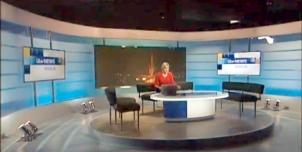Full Freeview on the Sudbury (Suffolk, England) transmitter
| Google Streetview | Google map | Bing map | Google Earth | 52.005,0.786 or 52°0'17"N 0°47'8"E | CO10 5NG |
The symbol shows the location of the Sudbury (Suffolk, England) transmitter which serves 440,000 homes. The bright green areas shown where the signal from this transmitter is strong, dark green areas are poorer signals. Those parts shown in yellow may have interference on the same frequency from other masts.
This transmitter has no current reported problems
The BBC and Digital UK report there are no faults or engineering work on the Sudbury (Suffolk, England) transmitter._______
Digital television services are broadcast on a multiplexes (or Mux) where many stations occupy a single broadcast frequency, as shown below.
64QAM 8K 3/4 27.1Mb/s DVB-T MPEG2
H/V: aerial position (horizontal or vertical)
The Sudbury (Suffolk, England) mast is a public service broadcasting (PSB) transmitter, it does not provide these commercial (COM) channels: .
If you want to watch these channels, your aerial must point to one of the 80 Full service Freeview transmitters. For more information see the will there ever be more services on the Freeview Light transmitters? page.
Which Freeview channels does the Sudbury transmitter broadcast?
If you have any kind of Freeview fault, follow this Freeview reset procedure first.Digital television services are broadcast on a multiplexes (or Mux) where many stations occupy a single broadcast frequency, as shown below.
64QAM 8K 3/4 27.1Mb/s DVB-T MPEG2
H/V: aerial position (horizontal or vertical)
The Sudbury (Suffolk, England) mast is a public service broadcasting (PSB) transmitter, it does not provide these commercial (COM) channels: .
If you want to watch these channels, your aerial must point to one of the 80 Full service Freeview transmitters. For more information see the will there ever be more services on the Freeview Light transmitters? page.
Which BBC and ITV regional news can I watch from the Sudbury transmitter?

BBC Look East (East) 0.8m homes 3.2%
from Norwich NR2 1BH, 77km north-northeast (24°)
to BBC East region - 27 masts.
70% of BBC East (East) and BBC East (West) is shared output

ITV Anglia News 0.8m homes 3.2%
from NORWICH NR1 3JG, 78km north-northeast (24°)
to ITV Anglia (East) region - 26 masts.
All of lunch, weekend and 80% evening news is shared with Anglia (West)
Are there any self-help relays?
| Felixstowe West | Transposer | 1000 homes +1000 or more homes due to expansion of affected area? | |
| Witham | Transposer | 14 km NE Chelmsford. | 118 homes |
How will the Sudbury (Suffolk, England) transmission frequencies change over time?
| 1984-97 | 1997-98 | 1998-2011 | 2011-13 | 1 Aug 2018 | |||||
| B E T | B E T | B E T | E T | K T | |||||
| C29 | SDN | ||||||||
| C31 | ArqA | ||||||||
| C35 | C5waves | C5waves | |||||||
| C37 | ArqB | ||||||||
| C41 | ITVwaves | ITVwaves | ITVwaves | D3+4 | D3+4 | ||||
| C44 | BBC2waves | BBC2waves | BBC2waves | BBCA | BBCA | ||||
| C47 | C4waves | C4waves | C4waves | BBCB | BBCB | ||||
| C51tv_off | BBC1waves | BBC1waves | BBC1waves | ||||||
| C56tv_off | ArqB | ||||||||
| C58tv_off | SDN | ||||||||
| C60tv_off | -ArqA |
tv_off Being removed from Freeview (for 5G use) after November 2020 / June 2022 - more
Table shows multiplexes names see this article;
green background for transmission frequencies
Notes: + and - denote 166kHz offset; aerial group are shown as A B C/D E K W T
waves denotes analogue; digital switchover was 6 Jul 11 and 20 Jul 11.
How do the old analogue and currrent digital signal levels compare?
| Analogue 1-4 | 250kW | |
| SDN, ARQA, ARQB, BBCA, D3+4, BBCB | (-4dB) 100kW | |
| Analogue 5 | (-7dB) 50kW | |
| Mux 2* | (-14.9dB) 8.1kW | |
| Mux B* | (-15.2dB) 7.5kW | |
| Mux 1* | (-15.5dB) 7kW | |
| Mux A* | (-17dB) 5kW | |
| Mux C* | (-22.2dB) 1.5kW | |
| Mux D* | (-23.6dB) 1.1kW |
Which companies have run the Channel 3 services in the Sudbury transmitter area
|
|
Wednesday, 25 April 2012
N
Nick7:38 PM
Woodbridge
Many thanks again JB. Log periodic are not for fringe areas though, so I think I might be better off with a large yagi, even if it is designed for group B. Aldeburgh is not technically within Sudbury's area.
I suppose I could have two aerials to cover both groups, but would probably lose out connecting them together. What a lot of problems are caused by a weak regulator who does not force high power relays to take all channels, and similarly allows freesat, set up to cater for those in poor areas to do the same.
| link to this comment |
Nick's: mapN's Freeview map terrainN's terrain plot wavesN's frequency data N's Freeview Detailed Coverage
N
Nick7:42 PM
Woodbridge
JB, do you know about DAB radio? We have a similar problem at Aldeburgh, a transmitter that carries only the BBC channels. I was thinking of trying to get the other channels from Mendlesham, but it seems even the transmitters that do provide all channels transmit the commercial ones on lower power. Do you know why?
| link to this comment |
Nick's: mapN's Freeview map terrainN's terrain plot wavesN's frequency data N's Freeview Detailed Coverage
J
jb388:38 PM
Nick: I would not let yourself be over influenced by looking at the gain figures claimed for aerials such as the type you have mentioned, as these figures are gathered from when the aerial is tested under strictest of conditions and in the most ideal of conditions, something which bears no resemblance to where most of them are used in the real world, as in practice and especially where difficult non line-of-site situations are involved, the general rule is the larger the aerial the sharper its acceptance angle is, the last thing thats wanted where elements of signal path warping is liable to occur, an aerial with a wider acceptance angle always performing better in these situations, and aided if necessary with an amplifier.
| link to this comment |
J
jb388:47 PM
Nick: Sorry, and although this may sound a bit odd, but although being a long standing engineer I dont really get involved with DAB radio or its reception, and as such am unable to advise on issues concerning it.
| link to this comment |
jb38: It's interesting the point you make about using an aerial with wider acceptance in combination with an amplifier where there is difficult non-line-of-sight. I've always wondered why you wouldn't just go with a higher gain aerial so as not to have to resort to amplification. This makes sense; thanks for the insight.
| link to this comment |
N
Nick10:44 PM
Woodbridge
Thank you gentlemen. The issue of aerials is quite confusing. If you go to ATV aerials site, they say the opposite, that a low gain aerial with wide acceptance angle plus booster is a poor substitute for a high gain aerial. But they do like log periodic, in areas of good signal strength. It also seems to be that boosters can do more harm than good on digital.
| link to this comment |
Nick's: mapN's Freeview map terrainN's terrain plot wavesN's frequency data N's Freeview Detailed Coverage
Nick: I do not believe that jb38 has implied that a lower gain aerial plus booster is a "substitute" for a high gain aerial. He has said that a lower gain aerial plus booster can be better in difficult non-light-of-sight situations.
That does not mean that high gain antennas don't have their uses. What ATV is probably saying is that a low gain antenna plus booster is NOT the equivalent of a high gain antenna without booster.
| link to this comment |
N
Nick11:50 PM
Nick: Thanks Dave. What part does non line of sight play though?
| link to this comment |
Thursday, 26 April 2012
Nick: Quite a lot.
Think of car headlights a night when they are coming towards you over the brow of a hill. Before they get over the brow, you do not have direct line of sight. You can see the growing mass of light above the horizon (which is the highest point).
Now imagine that the light is a signal you are trying to receive.
I believe that what jb38 is saying, is that it is best to use a low gain/wide acceptance aerial to collect this "mass of light" rather than a high gain/narrow acceptance one.
Read ATV's page on amplifiers:
Television Aerial Boosters / Amplifiers, Splitters, Diplexers & Triplexers
Amplification is fine so long as you are amplifying a small good quality signal. If you amplify a small poor quality signal then you will end up with a large poor quality signal.
Because a high gain aerial has a narrow range of acceptance, it is imperative for the signal to be "good" quality along that narrow path where it is most sensitive. If it's not, then all you'll have is a poor quality signal.
The suggestion that a low gain antenna is better means that the signal that it is "collecting" is over a wider surface area of the aerial. Therefore, if "some" of that is "poor" but most is "good", the "good" will win through and therefore the signal carried down the aerial lead will be "good".
Or to think of it another way, consider the high gain antenna with small acceptance angle. Let's suppose that "most" of that angle is filled with a signal that is "poor". The signal carried down the lead will therefore be "poor". Now imagine replacing the high gain aerial with a low gain one that has a wider acceptance angle. Because the "poor" bit is spread over much smaller proportion of the acceptance angle, it therefore follows that the signal from the aerial is better (albeit perhaps of smaller magnitude).
jb38, am I on the right lines?
| link to this comment |
N
Nick7:48 AM
Thank you Dave for your trouble in giving such a full answer.
Now let me throw another thing into the pot. I have recently been posting questions on the Tac site as I believe the mast height has been increased and coverage extended since going digital. I was advised that Sud is still my better option as at 10m it is technically line of site. So in theory the answer would be to get a good set of binoculars and see if it is!
| link to this comment |
Select more comments
Your comment please!




